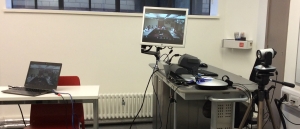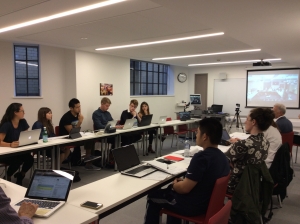LTI Grants aim to test new forms of teaching, learning, and assessment at LSE through the use of technology, with the aim of diversifying student experience. Last year LTI worked with the department of Government to run a multi-institution collaborative teaching project. The project evaluation provided recommendations for future implementation and is summarised below.
The project
2015/16 LTI grant winner, Dr Francisco Panizza from the Department of Government worked with LTI to set up a collaborative long distance course on the politics and political economics of the BRICS* countries. The transAtlantic course ran weekly as an elective pilot for students in the Michaelmas term 2015.
 | ||
| Using video conferencing technology, Dr Panizza delivered joint lectures with Tony Spanakos, Associate Professor in Department of Political science and Law at Montclair State University, USA. |
||
Despite a 5 hour time difference LSE students were able to view their American counterparts in real time and contribute to discussions in the joint classroom, allowing them to benefit from a variety of viewpoints and experiences. The technology also enabled additional speakers to guest lecture including Professor Lucius Botes, from the University of the Free State in South Africa.
Each two-hour session was based on a case study of a BRICS country. Students were asked to work in cross University groups on a summit presentation and used the VLE (Virtual Learning Environment) Canvas to plan and discuss presentations. Despite being a voluntary course double the number of LSE students applied to take part than were spaces available.
Course evaluation surveys indicated that students were very interested in the course content, non-Western accounts of the global South are not usually part of the undergraduate curriculum. The interdisciplinary approach of the course and opportunity to work with students from another university were also stated as reasons for applying to take part.
 The lecturers aimed to ‘diversify and deepen the learning experience by allowing students the opportunity to hear and engage with multiple perspectives on a common theme’, and engage with the politics of the BRICS in a ‘far more diverse context than would have been possible otherwise’. The students reported that the opportunity to have two professorial voices in one classroom was appreciated and the Q&As were very stimulating. The lecturers noted that several students developed meaningful interactions with them and were able to broaden their advice for essays. However careful preparation is required to allow for a seamless experience with technology. Classes are easily delayed if video conferencing technology is not set up in advance and there are any technical problems. The time difference is another factor that has to be taken into account.
The lecturers aimed to ‘diversify and deepen the learning experience by allowing students the opportunity to hear and engage with multiple perspectives on a common theme’, and engage with the politics of the BRICS in a ‘far more diverse context than would have been possible otherwise’. The students reported that the opportunity to have two professorial voices in one classroom was appreciated and the Q&As were very stimulating. The lecturers noted that several students developed meaningful interactions with them and were able to broaden their advice for essays. However careful preparation is required to allow for a seamless experience with technology. Classes are easily delayed if video conferencing technology is not set up in advance and there are any technical problems. The time difference is another factor that has to be taken into account.
Adapting the pedagogical approach
The evaluation of the BRICS project highlighted the need to develop new teaching methods and forms of student participation that take full advantage of new communication technologies.
As Senior Learning Technologist Kris Roger notes:
“As soon as you introduce the element of distance to a course, then you need to fundamentally rethink how you go about your teaching. […]. Not replicate exactly what we do as a face to face class. It’s like really embedding the distance, the technology, into practice rather than just focusing on preparing the class and the content and switching on the video and getting started”
The evaluation highlighted that the traditional LSE format of a lecture followed by a seminar did not translate well into this pilot, as lectures took over the collaboration time between LSE and MSU students. Not only did more class time need to be devoted to enabling student collaboration but students needed more support with the initial forming and communicating in groups. Lecturers reported assuming that students would be more comfortable choosing their own technology to communicate with each other; however, students found the multiplicity of platforms and lack of guidance confusing. Once the platform Canvas had been selected for collaboration, students’ began effective discussions online and often reverted to using their own tools such as Whatsapp, Skype and Google Docs. This supports findings by LSE SADL that although students may be comfortable with using technology in their personal lives they are not familiar with applying these tools to their academic work.
Recommendations and next steps
Collaborative teaching and learning is a new area for LSE and as Dr Panizza noted “we only scratched the surface of a teaching experience full of possibilities”. You can read the reflections of the course lecturers on the LTI blog.
One of the issues that was raised in the evaluation of this project was the role of LTI and how to better communicate our expertise as learning technologists. Our aim is to ensure that where technology is used it extends teaching opportunities, enriches the student learning experience. We now plan to embed training for collaborative teaching within future projects to support lecturers to adapt a more student centred approach. Some of the recommendations for future collaborative projects are listed below:
- Adopt a student-centred approach with emphasis on collaboration.
- Clear information from the start: centralised platform or communication channel with information on the course; project goals, choice of technology and links between students’ contributions and evaluation need to be communicated.
- Form and introduce the groups and the collaboration platform to be used at the start of the project. Students may still choose their own platform if they wish.
- Clear instructions including roles and responsibilities along with a discussion on role norms and social etiquette for students working on collaborative projects.
- Use of a structured grading rubric to enable monitoring and encourage participation and collaboration.
- Sustain Learning Activities such as writing, reviewing and revising throughout the learning process.
It is hoped that more collaborations can take place and we can develop our experience of working with other institutions. If you would be interested in working on a collaborative project or have another idea for innovation with technology for the pedagogic benefit of students then contact LTI. LTI grants applications are now open for 2017 for more details see the LTI website.
*BRICS (Brazil, Russia, India, China and South Africa)








